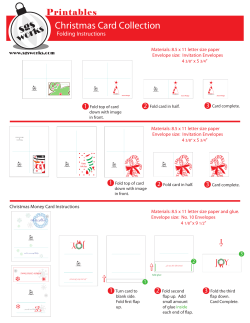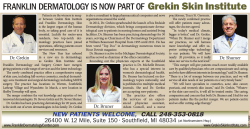
Another prevalent transverse linear crease of the face, the
Letters 1. Picardi A, Pasquini P, Cattaruzza MS, et al. Psychosomatic factors in firstonset alopecia areata. Psychosomatics. 2003;44(5):374-381. 2. Vannatta K, Gartstein MA, Zeller MH, Noll RB. Peer acceptance and social behavior during childhood and adolescence: how important are appearance, athleticism, and academic competence? Int J Behav Dev. 2009;33(4): 303-311. OBSERVATION Deep Labiomental Fold With Pseudocomedones The labiomental fold is a transverse indentation of the face, which marks the intersection of the lower lip and chin.1 It plays a significant role in movement of the lower lip and in facial expression. We describe herein a child with a linear pattern of microcomedones located along a deep labiomental fold. Report of a Case | A 7-year-old healthy girl presented with a line of black papules on her chin. On examination, the child had a protruded chin with a relatively deep labiomental groove. Several open comedones were aligned along the groove (Figure). Acneiform lesions were not present in any other location on her face or upper trunk. Discussion | Three muscles, the circular orbicularis oris, depressor labii inferioris, and mentalis align the labiomental fold or cross it as they pass to their insertion.2 The fibers of the 3 muscles are attached to the skin by thick bands of fibroelastic fibers. The mentalis muscles originate from the mandible and serve as paired elevators of the central lower lip.3 They usually overlap and insert into the deep dermis of the chin pad. Patients with substantial overlap of the mentalis muscles tend to have a deep labiomental fold.3 The presence of a deep labiomental fold is a relatively common condition and may sometimes cause an aesthetic concern.4 Procedures for treating deep labiomental fold are sometimes discussed in the plastic surgery literature, but it has been rarely reported in the dermatology literature. To our knowledge, this is the first report of a dermatologically related condition associated with this fold. Another prevalent transverse linear crease of the face, the nasal crease, appears across the lower third of the nasal dorsum. In some cases, changes of pigmentation, milia, or pseudocomedones are present along the nasal crease.5 Transverse nasal milia in the absence of a transverse nasal crease are less frequently reported. Recently, our research team6 reported a case of seborrheic keratosis–like hyperplasia and horn cysts aligned along this crease. These findings were attributed to the fact that the triangular cartilage and the alar cartilage attach in a linear fashion at the junction of the middle and lower third of the nose, producing a potential embryonic fault line in which retention cysts presenting as milia and comedones can occur.5 Early acne lesions favor the forehead, nose, and chin in many children. Although many times overlooked, the external ear is another common location for open and closed comedones in young patients with acne.7 We think that the common concave surface of the nasal crease, deep labiomental fold, and external ear may facilitate the appearance of retention lesions in those locations. In conclusion, we think that the labiomental fold, a transverse fold of the chin, can harbor retention cysts or comedones in a similar fashion to the nasal crease. Dermatologists should be aware of this fold, since it might be encountered in the dermatology practice and may be associated with additional dermatologic conditions. Liran Horev, MD Abraham Zlotogorski, MD Yuval Ramot, MD, MSc Author Affiliations: Department of Dermatology, Hadassah-Hebrew University Medical Center, Jerusalem, Israel (Horev, Zlotogorski, Ramot). Corresponding Author: Liran Horev, MD, Department of Dermatology, Hadassah-Hebrew University Medical Center, PO Box 12000, Jerusalem 91120, Israel (liran.horev@gmail.com). Conflict of Interest Disclosures: None reported. 1. Reyneke JP, Ferretti C. Clinical assessment of the face. Semin Orthod. 2012;18(3):172-186. 2. Cardoso ER, Amonoo-Kuofi HS, Hawary MB. Mentolabial sulcus: a histologic study. Int J Oral Maxillofac Surg. 1995;24(2):145-147. Figure. Deep Labiomental Fold and Open Comedones in a Linear Pattern Along the Fold 3. Garfein ES, Zide BM. Chin ptosis: classification, anatomy, and correction. Craniomaxillofac Trauma Reconstr. 2008;1(1):1-14. 4. Suryadevara AC. Update on perioral cosmetic enhancement. Curr Opin Otolaryngol Head Neck Surg. 2008;16(4):347-351. 5. Waller B, Haber RM. Transverse nasal crease and transverse nasal milia: clinical variants of the same entity. Arch Dermatol. 2012;148(9):1037-1039. 6. Ramot Y, Maly A, Zlotogorski A, Nanova K. Atypical “allergic crease”. J Dermatol Case Rep. 2010;4(3):36-37. 7. del Río E. Peculiar distribution of comedones: a report of three cases. Dermatology. 1997;195(2):162-163. Successful Treatment of Ulcerative and Diabeticorum Necrobiosis Lipoidica With Intravenous Immunoglobulin in a Patient With Common Variable Immunodeficiency Several comedone openings are marked by arrows. jamadermatology.com Downloaded From: http://jamanetwork.com/ on 09/09/2014 Necrobiosis lipoidica (NL) is an idiopathic inflammatory skin disorder that rarely resolves spontaneously, and ulceration is a major complication. Although NL occurs in less than 1% of patients with diabetes mellitus, 75% of NL cases are associated with diabetes.1 JAMA Dermatology July 2013 Volume 149, Number 7 879 Letters Figure 1. Clinical Images of Affected Areas Before Treatment A B Lower pretibial right (A) and left (B) legs before intravenous immunoglobulin therapy showing large and ulcerative plaques of necrobiosis lipoidica. Figure 2. Clinical Image of Affected Areas After Treatment Lower pretibial aspect of the legs after Intravenous Immunoglobulin therapy showing substantial healing. 880 JAMA Dermatology July 2013 Volume 149, Number 7 Downloaded From: http://jamanetwork.com/ on 09/09/2014 Common variable immunodeficiency (CVID) is the most frequent symptomatic primary immunodeficiency encountered in adults: incidence is estimated at between 1 in 10 000 and 1 in 50 000. Because of the heterogeneity of this disorder, no targeted therapy has been defined except intravenous immunoglobulin (IVIG).2 Herein, we describe a patient with diabetes who experienced a successful combined treatment of NL ulcers and CVID with IVIG. Report of a Case | A 63-year-old white woman with diabetes was referred to us with a 7-year history of ulcerating and very painful NL lesions on her shins, which had gradually enlarged during this period. The patient was a smoker and had a history of well-controlled type 2 insulin-treated diabetes mellitus (hemoglobin A1c proportion, 6.1%) with no additional diabetic complication. Physical examination revealed atrophic, yellow-brown, telangiectatic plaques affecting her lower legs. The lesions had large, deep, and crusting ulcerations (Figure 1). Cutaneous biopsy findings were compatible with NL, and direct immunofluorescence findings were negative. The patient had previously received treatments with topical corticosteroid, topical tacrolimus, hydroxychloroquine, psoralen plus UV-A, and pentoxifylline without any significant clinical response. Owing to recurring ear, nose, and throat infections, CVID was suspected. Immunologic tests revealed a poor response to vaccines (pneumococcus and diphtheria) and reduced serum immunoglobulin concentrations (IgG, IgM, and IgA at 77, 23, and 40 mg/dL, respectively). No secondary cause of hypogammaglobulinemia was observed (no history of immunosuppressive therapy, digestive symptoms of inflammatory disease, nor evidence for neoplasia by thoraco-abdominal computed tomographic scan and flow cytometry). jamadermatology.com Letters The patient was subsequently treated with IVIG, 0.4g/ kg/d, for 5 consecutive days for her newly diagnosed CVID, while local application of paraffin gauze dressing (Jelonet; Smith & Nephew) was maintained. Surprisingly, 3 weeks after this single cycle, all ulcerations had healed (Figure 2), and complete resolution of pain was reported. The immunoglobulin levels remained stable 3 months after IVIG treatment, and no further ulcerations were detected during a 2-year follow-up, and so the patient did not require additional therapy. Discussion | In our case, no significant success was observed in reduction of NL ulcers after administration of currently accepted treatments, the efficiency of which was known to be limited. Interestingly, treatment of the patient’s CVID with IVIG appeared to heal the ulcers within 3 weeks. As the IVIG treatment showed a similar dramatic ulcer reduction within 2 weeks in a previous case3 (where no investigation of associated hypogammaglobulinemia was performed), the immunologic aspect of NL appears of major importance in these patients. Because of its strong association with diabetes, NL has been postulated to arise due to microangiopathic vascular changes. Therefore, NL might be due to immunologically mediated vascular changes.4,5 In this context, measures of serum immunoglobulin levels and direct immunofluorescent histologic study might be recommended in NL. Our findings suggest that IVIG can be a successful option in the treatment of NL, particularly in patients with CVID, while a broader approach in NL without underlying CVID requires further investigations. Neda Barouti, MD Amy Qian Cao, H BSc Donato Ferrara, MD Christa Prins, MD Author Affiliations: Department of Medical Specialties–Dermatology, University Hospitals of Geneva and Faculty of Medicine, Geneva, Switzerland (Barouti, Qian Cao, Ferrara, Prins); Queen’s University School of Medicine, Kingston, Ontario, Canada (Qian Cao). Corresponding Author: Neda Barouti, MD, Rue Gabrielle-Perret-Gentil 4, 1205 Genève, Switzerland (neda.barouti@hcuge.ch). Conflict of Interests Disclosures: None reported. Funding/Support: This study was supported by the University Hospitals of Geneva, Geneva, Switzerland. Role of the Sponsors: The sponsors had no role in the design and conduct of the study; in the collection, analysis, and interpretation of data; or in the preparation, review, or approval of the manuscript. 1. Ngo B, Wigington G, Hayes K, et al. Skin blood flow in necrobiosis lipoidica diabeticorum. Int J Dermatol. 2008;47(4):354-358. 2. Salzer U, Warnatz K, Peter HH. Common variable immunodeficiency: an update. Arthritis Res Ther. 2012;14(5):223. 3. Batchelor JM, Todd PM. Treatment of ulcerated necrobiosis lipoidica with intravenous immunoglobulin and methylprednisolone. J Drugs Dermatol. 2012;11(2):256-259. 4. Quimby SR, Muller SA, Schroeter AL. The cutaneous immunopathology of necrobiosis lipoidica diabeticorum. Arch Dermatol. 1988;124(9):1364-1371. 5. Laukkanen A, Fräki JE, Väätäinen N, Korhonen T, Naukkarinen A. Necrobiosis lipoidica: clinical and immunofluorescent study. Dermatologica. 1986;172(2): 89-92. jamadermatology.com Downloaded From: http://jamanetwork.com/ on 09/09/2014 Intralesional Cidofovir for Treating Extensive Genital Verrucous Herpes Simplex Virus Infection Verrucous herpes simplex viral infections in immunocompromised patients can be a therapeutic challenge, and we present a case of successful treatment with intralesional cidofovir. Report of a Case | A 55-year-old man with human immunodeficiency virus (HIV) and hepatitis C virus coinfection presented with new lesions on his scrotum and perianal area. He noted mild tingling and slow growth over the prior 2 months. His medications included darunavir, ritonavir, emtricitabine/ tenofovir, and trimethoprim-sulfamethoxazole. His CD4 count was stable at 350 cells/μL, and he had an undetectable HIV viral load. Findings of a comprehensive metabolic panel and complete blood cell count were normal, and rapid plasma reagin was nonreactive. Physical examination was notable for exophytic, verrucous, and ulcerated plaques on his right inferior scrotum and perianal area (Figure 1A and B). Biopsy and tissue culture were performed. Histopathologic analysis demonstrated full-thickness epidermal ulceration with adjacent pseudoepitheliomatous hyperplasia (Figure 2A and B). Multinucleated keratinocytes with peripheral rimming of nuclear chromatin were present at the edge of the ulceration (Figure 2B and C), and immunostaining for herpes simplex virus (HSV) was positive, confirming HSV infection (Figure 2D). Gram and periodic acid-Schiff stainings and Treponema pallidum immunostaining were negative. Tissue culture had no growth, and viral resistance testing could not be performed. The patient began treatment for HSV, and despite successive 1-month courses of high-dose oral acyclovir, valacyclovir, and famciclovir, his lesions progressed. A repeated tissue culture for viral resistance testing was not successful in growing virus. A repeated biopsy confirmed the original diagnosis of verrucous HSV. Given concern for acyclovirresistant HSV, oral therapy was discontinued, and intravenous (IV) cidofovir treatment was initiated, with improvement noted after 3 doses. This treatment was complicated by elevations in serum creatinine levels and discontinued. Intralesional cidofovir was then initiated every other week, as previously reported,1 with resolution of his scrotal lesion and dramatic improvement in his perianal lesion after 6 treatments (Figure 1C and D). Discussion | Herpes simplex virus infections cause significant morbidity in immunocompromised patients, and active HSV infection increases HIV transmission.2 Infection with acyclovirresistant HSV strains is about 10-fold higher in patients with HIV than in immunocompetent individuals and appears related to the degree of immunosuppression and duration of antiretroviral therapy. 2 Treatment options for acyclovirresistant HSV are limited and include foscarnet, cidofovir, imiquimod, and immunomodulating dipeptides.3,4 Foscarnet and cidofovir are not dependent on phosphorylation of viral thymidine kinase for activation and can therefore be used in acyclovir-resistant cases; however, both have limited formulations, and drug-induced nephrotoxic effects are potentially serious complications. Topical and intralesional adminJAMA Dermatology July 2013 Volume 149, Number 7 881
© Copyright 2025
















